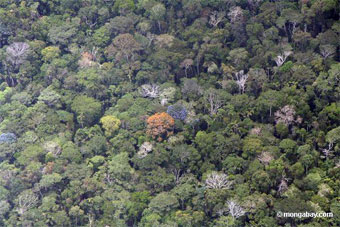Rainforest tree diversity may be tied to seed dispersal
Rainforest tree diversity may be tied to seed dispersal
mongabay.com
November 28, 2006
A new study says tree distribution in the rainforest is highly dependent on species’ method of seed dispersal. The research could help explain how a large number of rainforest trees can coexist in a small area.
Joshua B. Plotkin of Harvard University and Tristram Seidler of Imperial College in England analyzed the dispersal mechanisms and spatial distributions of 561 tree species in a 50-hectare plot of lowland tropical forest at Pasoh Forest Reserve in peninsular Malaysia. The found that trees with smaller fruit tended to be less widely dispersed than trees with large fruit, suggesting that larger-bodied birds and mammals carry the seeds of these tree species over greater distances. Plotkin and Seidler also found that trees with wind-dispersed seeds were situated in tight cluster, indicative of the weak breeze in the forest canopy.
“Overall, there is a highly significant relationship between mode of seed dispersal and the clustering and arrangement of mature trees in the rainforest,” said Plotkin. “This strong correlation demonstrates the long-term impact that these dispersal methods have on the organization of the large-scale forest.”
 Rainforests have incredible levels of tree biodiversity. One study in the Amazon rainforest of Brazil found 487 tree species growing on a single hectare (2.5 acres). In comparison, the United States and Canada combined only have 700 species of trees. |
The scientists say that their research is the first experimental evidence of such trends for an entire forest community and that the findings are likely applicable to other forest regions.
“Our results provide broad empirical evidence for the importance of dispersal mode in establishing the long-term community structure of tropical forests,” added Plotkin.
The research is published in the November issue of the journal Public Library of Science – Biology.
This article is based on a news release from Harvard University.